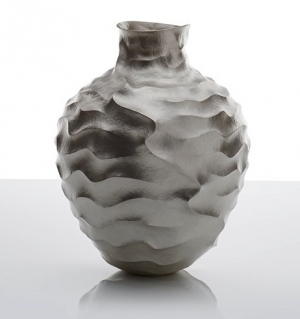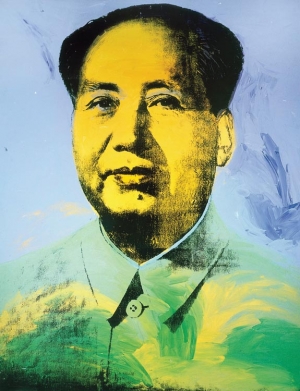|
Displaying items by tag: Charles Saatchi
She was his trusted righthand woman for seven years, guiding his artistic brainchild, but now Charles Saatchi is embroiled in a bitter legal battle with his former gallery director accusing her of trading on his name.
Rebecca Wilson had worked closely with him as his director at the Saatchi Gallery in London, she was pivotal in his plans to donate £25 million of art work to the nation and even judged his school art competitions.
But following a move to run Saatchi Online in the US the pair have since fallen out over an insignificant £10,000 sponsorship fee for an art exhibition.
All sorts of paths can lead to an art career—and a nation-wide media frenzy never hurts. Francesca Grillo hit the headlines last year, when she was accused, alongside her sister Elisabetta, of defrauding über-collector Charles Saatchi and his former wife Nigella Lawson of £685,000 ($1,140,500) with company credit cards. The sisters were found not guilty in December 2013.
One might have thought that Francesca had seen enough of the art world at the Saatchi-Lawson residence to want to start afresh somewhere else. Quite the opposite. She has teamed up with another former Saatchi employee, Sharrine Scholtz, to launch a gallery-without-walls, Laissez Faire Art.

Masterpiece London, a high-end art and antiques fair offering an eclectic mix of paintings, design, furniture, and jewelry, kicked off its fifth edition with an exclusive preview on Wednesday, June 25 at the Royal Hospital Chelsea. The fair, which is located near London’s posh Chelsea neighborhood, got off to a strong start thanks to impressive sales and record attendance. Noteworthy visitors included collector Charles Saatchi, interior designers Ellie Cullman and Scott Snyder, fashion designers Zandra Rhodes and Tom Ford, and a number of museum leaders such as Jeffrey Munger, The Metropolitan Museum of Art’s Curator of European Porcelain, and Stephen Harrison, the Cleveland Museum of Art’s Curator of Decorative Art and Design.
A positive tone was set early on when Symbolic and Chase (London) sold a 1912 Cartier Corsage for more than $20 million. Other sales highlights during the preview included a pair of chinoiserie cabinets by Vile and Cobb sold by Apter Fredericks (London) to an American collector for a seven figure sum; a portrait of the Countess of Craven sold by Elle Shushan (Philadelphia) to English actress Diana Rigg; and Lynn Chadwick’s “Back to Venice” sculpture that was sold by Osborne Samuel (London) for £250,000. Strong sales are expected to continue through the weekend.
British collector Charles Saatchi will sell Tracey Emin’s iconic readymade, “My Bed,” on July 1 at Christie’s. The work, which is quite literally the artist’s unmade bed -- complete with empty vodka bottles, cigarette butts, and discarded undergarments -- carries a pre-sale estimate of £800,000 to £1.2 million, which many people feel is too low considering the piece’s storied past.
Emin was a founding member of the Young British Artists (YBAs), a group of visual artists who first began to exhibit together in London in the late 1980s and favored everyday materials, shock tactics, and wild-living. Created in 1998 following a particularly low period in Emin’s life, “My Bed” earned a Turner Prize nomination in 1999, which sparked outrage among the art world. A year later, Saatchi purchased “My Bed” from Emin’s New York dealer, David Maupin, for £150,000, a hefty price tag at the time.
It is considered one of the most important contemporary art collections in the world, featuring Tracey Emin’s bed and Grayson Perry’s pots.
So when Charles Saatchi offered to donate the cream of his private collection – valued at upwards of £30 million – to the nation for free, he might have been forgiven for thinking it would be gratefully accepted.
But two years since announcing his generous gift, the collection has yet to find a home.
Instead, the Government has bungled attempts to secure it while a national museum has also passed on the offer.
Saatchi’s bequest includes more than 200 works by several of the world’s leading contemporary artists, among them Jake and Dinos Chapman, the Indian artist Jitish Kallat and Emin, whose unmade bed, My Bed, which came to symbolise the Young British Artist (YBA) movement of the 1990s, is included.
So reclusive that he does not attend even his own parties, Charles Saatchi has, nevertheless, felt compelled to become involved in a very public dispute.
The husband of Nigella Lawson has issued a writ at the High Court in London against his publishers, Phaidon Press.
Saatchi, who is this country’s biggest collector of contemporary art, claims that part of his agreement with the publisher is void and unenforceable.

Charles Saatchi is the most influential collector of the past 25 years, and one of the most controversial. Notorious for never appearing at his own openings and for not granting interviews, the British former advertising magnate remains a mysterious figure who wields his influence through his Saatchi Gallery shows and the subsequent sale of the artworks in them; to this day he continues to influence the market for contemporary art in his Gatsbyesque style. I’ve met him only once, at a London restaurant with our mutual friend Jean Pigozzi; Mr. Saatchi picked up the tab, which was generous of him since he was on a diet and ate almost nothing.
A new edition of The History of the Saatchi Gallery (Booth-Clibborn, 1,008 pages, $85.00) has just been released. It’s a reprint of the same title done in a monster-size “OPUS” edition in 2009. Now that it’s available in a manageable size, it’s time to buy it and study it. I scored my signed copy at Sotheby’s in London during last month’s auction previews. This tome is essential for serious art collectors because it shows us the amazing breadth of what Mr. Saatchi has bought, exhibited and sold between 1985 and 2009, following a collecting model I’ve dubbed the “show and sell.” There are many questions surrounding the underlying meaning of his collecting activity, and the morality of his method; just about everything about Mr. Saatchi interests me, in fact, because there’s a lot of Saatchi-ness in today’s art market.
What motivated Mr. Saatchi to produce the oversize book two years ago and to republish it today in a smaller but still jumbo size is no doubt both his ongoing need for recognition and his desire to donate his gallery with its sundry art leftovers to the British government, presumably so that he won’t have to continue underwriting it himself. He tried to get out from under it last July (see my article from Nov. 3, 2010) but that deal fell apart over the gallery’s plan to fund itself through future purchases and sales, a practice that violates museum bylaws in Britain and everywhere else. But buying and selling is what Mr. Saatchi has done for years, and it has worked amazingly well for him it seems, at least until fairly recently.
Flipping through the book, I couldn’t help but marvel at the amazing Warhols he owned, the Judds and the Mardens, the Freuds and the Serras, though sadly for him he owned no Lichtensteins, Bacons or Basquiats. I couldn’t stop myself from adding up what these artworks would be worth today, forgetting Mr. Saatchi’s recent shows and sticking only to the really good stuff he had up until the end of the mid-’90s: I easily came up with $1.5 billion. Even this past decade he proved he still had the eye when he bought, exhibited and then sold great painters like Marlene Dumas, John Currin and Peter Doig and even a few emerging artists, like the then-up-and-coming Mark Grotjahn, who have since garnered blue-chip status. He also had great sculptors like Charlie Ray and Thomas Schutte, but over time his hit ratio has been going down, the proof of this being the book’s inclusion of some horrid and unforgivable chazerai—junk food—that you couldn’t pay me to hang in my house.
Making things more difficult for Mr. Saatchi today is the fact that the art market has become more efficient, and he’s often priced out of it. Rising art prices have forced him to eschew the four-man shows of famous artists he used to do in favor of broader and broader shows with catchy adman titles like “Painting Today” or “Sculpture Tomorrow,” probably because his buy-show-sell strategy has become riskier and less lucrative; art today is fully valued and looks like it will remain so.
When those drift-net shows dead-ended, he went ethnic, with Indian art, then Chinese art, and I’ve already forgotten what else. It’s all worth studying because he has successfully invented a new way to collect art, though sadly now the overall quality of the work keeps forcibly trending down.
Part of me feels Mr. Saatchi never should have moved beyond the original show of 1985, “Judd, Marden, Twombly, Warhol.” It was so good it could have stayed up permanently. As crazy as this sounds, and though it wouldn’t cause any “sensation,” the quality was outstanding, and it would be worth a helluva lot more money than whatever is left in his collection today. In fact, the number of never-ever-to-be-seen-again-on-the-market works that he has shown and sold over the years is downright depressing.
So what conclusions, if any, am I to draw from all this? I asked a wise veteran, art dealer Arne Glimcher, founder of the Pace Gallery, who has dealt with Mr. Saatchi over the years; his answer: “Charles was always a dealer.”
Many would concur, but I don’t; if you’ve owned all that, even if most of it is long gone, then you are what they call a collector-dealer. And, yes, Mr. Saatchi is the original collector who deals. The very reason why Mr. Saatchi, who should instead be lauded for what he’s done for art, is more often maligned by the “art world” is that he regularly sells anything he can. The art world to this day loves to adhere to its hypocritical views that dealers are permitted to sell for profit but “collectors” should not do the same.
I’ve had to deal with this disingenuous hypocrisy for over a decade, but as archaic and absurd as this may sound, most of the art world still buys into the charade. Though I can’t compare myself to Mr. Saatchi, I too have sold art to buy more art, and I refuse to bow to any false moral judgments that others may cast upon me; nor will I behave like a rich, vacuum-cleaner-style collector. I’ll let others play that role.
It’s a well-known fact that in 2007 I sold a fabulous sculpture by Jeff Koons at auction and it achieved the highest price ever paid for an artwork by a living artist. It was a great work by a great artist and it made a great price, so why should I feel badly about a sale that was good for the market, good for the gallery (prices jumped for new works) and a good market confirmation of the artist’s enormous stature? Instead, I received several dirty looks and was accused of being a profiteer: all sour grapes, I’m afraid.
This brings us to the tired old story of how Charles Saatchi ruined Italian painter Sandro Chia’s market when he dumped a suite of Mr. Chia’s paintings at auction years ago—what rubbish that all is. Mr. Chia is a minor figure today; his paintings just aren’t that interesting. Mr. Saatchi didn’t sell just his Chias; he’s dumped everything for years, including his John Currins and his Peter Doigs, but those works have gone straight up into the millions of dollars. As a matter of fact, a Doig painting made $10 million in London last month and collector demand for work by John Currin has never been stronger.
|
|
|
|
|